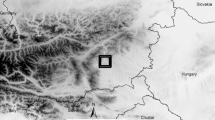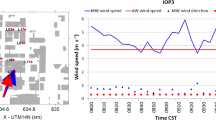Abstract
The accuracy of an environmental impact assessment study in analyzing the consequences of either continuous or accidental releases in the atmosphere is critical especially when adverse health effects are expected to be found. High accuracy is hard to be achieved in complex areas where land/sea breeze and topography give rise to complex circulation patterns. In these conditions stationary modeling systems such as the Gaussian often fail, providing misleading results which in turn lead to poor mitigation and control strategies. Conversely, advanced modeling systems, able to deal with inhomogeneous and non stationary atmospheric phenomena, can be expected to achieve better accuracy. The present study shows the application of a modeling system, composed by a diagnostic meteorological model and a Lagrangian particle model, to assess the environmental impact of a cement plant located close to a populated urban area in central Italy and characterized by complex topography and atmospheric circulation. 3-D wind and temperature fields, produced by interpolation of ground and vertical remote sensing meteorological data, have been provided to a particle dispersion model to calculate 3-D concentration of NOx, SO2 and CO in a 10 × 10 km2 domain. Comparison of results with observations confirms that the modeling system is able to achieve high accuracy when high quality data are provided as input. The applied methodology has shown that a modeling system can be used to provide local authorities and plant managers with a valid tool for consequences analysis studies.
Similar content being viewed by others
References
Aria: 2002, ‘ARIA Industry user manuals’, ARIA Technologies, 17 Route de la Reine 92517 Boulogne Billancourt Cedex France.
BADC: 2003, British Atmospheric Data Center, http://badc.nerc.ac.uk/data/radiosglobe/.
Brotzge, J. A. and Crawford, K.: 2000, ‘Estimating sensible heat flux from the Oklahoma Mesonet’, J. Appl. Meteor. 39, 102–116.
Brusasca, G., Carboni, G., Finardi, S., Sanavio, D., Tinarelli, G. and Toppetti, A.: 2001, ‘Comparison of a Gaussian (ISC3) and a Lagrangian Particle Model (SPRAY) for regulatory application in flat and complex terrain sites representative of typical Italian landscape’, Proceedings of the 7th Int. Conf. on Harmonisation within Atmospheric Dispersion Modelling for Regulatory Purposes, Belgirate, Italy, 28–31 May 2001.
Cressman, G. P.: 1959, ‘An operational objective analysis system’, Mon. Weather Rev. 87, 367–364.
De Maria, R., Clemente, M., Lollobrigida, F., Calori, G., Finardi, S. and Tinarelli, G.: 2003, ‘Air quality integrated assessment in Turin urban area using atmospheric transport and dispersion models’, Proceedings of the 4th International Conference on Urban Air Quality — Measurement, Modelling and Management, Prague, Czech Republic, 25–27 March 2003.
ETC/LC: 1997, ‘European Topic Centre of Land Cover (ETC/LC) — European Environmental Agency (EEA), Environment Satellite Data Centre P.O. Box 806 SE-981 28 KIRUNA, Sweden.
Finardi, S., Morselli, M. G., Brusasca, G. and Tinarelli, G.: 1997, ‘A 2-D meteorological preprocessor for real-time 3-D ATD models’, Int. J. Environ. Pollut. 8(3–6), 478–488.
Finardi, S., Tinarelli, G., Nanni, A. and Brusasca, G.: 1999, ‘Evaluation of a 3–D flow and pollutant dispersion modelling system to estimate climatological ground level concentrations in complex coastal sites’, Proceedings of the 6th Int. Conf. on Harmonisation within Atmospheric Dispersion Modelling for Regulatory Purposes, Rouen, France, 11–14 October 1999.
Finardi, S., Tinarelli, G., Nanni, A., Anfossi, D., Ferrero, E. and Trini Castelli, S.: 2000, ‘In situ diagnostic or nested prognostic meteorological models to drive dispersion simulations in complex area: A comparison in a real application’, Proceedings of the Millennium NATO/CCMS conference, Boulder, Colorado.
Finardi, S., Agnesod, G., Brusasca, G., Calori, G., Nanni, A., Pession, G., Tinarelli, G. and Zublena, M.: 2002, ‘Integrated air quality assessment of an Alpine region: Evaluation of the Mont Blanc tunnel re-opening effects’, Proceedings of the 8th Int. Conf. on Harmonisation within Atmospheric Dispersion Modelling for Regulatory Purposes, Sofia, Bulgaria, 14–17 October 2002.
Geai, P.: 1987, ’Methode d'interpolation et de reconstitution tridimensionelle d’un champ de vent: Le code d'analyse objective MINERVE’, Rep. ARD-AID: E34-E11, EDF, Chatou, France.
Hanna, S. R.: 1982, ‘Applications in Air Pollution Modeling’, in F. T. M. Nieuwstadt and H. Van Dop (eds), Atmospheric Turbulence and Air Pollutin Modelling, Reidel, Dordrecht, Chapter 7.
METEK: ‘DPDPA.90 User Manual’, METEK GmbH 2000.
Morselli, M. G., Calori, G., Finardi, S. and Mazzola, C.: 1997, ‘A 3-D wind and temperature preprocessor for ATD models’, Int. J. Environ. Pollut. 8(3–6), 489–499.
Pelliccioni, A., Venturini, C., Angeloni, M., Poli, U. and Lepore, L.: 1996, ‘Studio previsionale dello stato di qualità dell’aria nel territorio del comune di Guidonia‘ Tech. Rep. ISPESL-DIPIA No. 3997, Novembre 1996.
Sansigolo Kerr, A. F, Anfossi, D., Da Costa Carvalho, J., Finardi, S. and Trini Castelli, S.: 2001, ’Analysis of the middle range transport of the aerosol from Cubatao by means of a modelling system for complex terrain‘, Proceedings of the 7th Int. Conf. on Harmonisation within Atmospheric Dispersion Modelling for Regulatory Purposes, Belgirate, Italy, 28–31 May 2001.
Stull, R. B.: 1989, An Introduction to Boundary Layer Meteorology, Kluwer Academic Publishers, Dordrecht, Chapter 9.
Thomson, D. J.: 1987, ’Criteria for the selection of stochastic models of particle trajectories in turbulent flows‘, J. Fluid Mechanics 180, 529–556.
Tinarelli, G., Anfossi, D., Brusasca, G., Ferrero, E., Giostra, U., Morselli, M. G., Moussafir, J., Tampieri, F. and Trombetti, F.: 1994, ’Lagrangian particle simulation of tracer dispersion in the Lee of a schematic two-dimensional hill, J. Appl. Meteor. 33, 744–756.
U.S. EPA: 1995, ‘Users Guide for the Industrial Source Complex Dispersion Models (Revised), Volume I: User Instruction — Volume 2: Description ofModel Algorithms’, Rep EPA, EPA-454/B-95-003b.
Van Ulden, A. P. and Holtslag, A. A. M.: 1985, ‘Estimation of atmospheric boundary layer parameters for diffusion application’, J. Clim. Appl. Meteor. 24, 1196–1207.
Zannetti, P.: 1990, Air pollution Modelling: Theories, Computational Methods and Available Software, Computational Mechanics Publications, Southampton Boston, Van Nostrand Reinhold ed., New York.
Author information
Authors and Affiliations
Corresponding author
Rights and permissions
About this article
Cite this article
Gariazzo, C., Pelliccioni, A., Bogliolo, M.P. et al. Evaluation of a Lagrangian Particle Model (SPRAY) to Assess Environmental Impact of an Industrial Facility in Complex Terrain. Water, Air, & Soil Pollution 155, 137–158 (2004). https://doi.org/10.1023/B:WATE.0000026525.82039.ef
Issue Date:
DOI: https://doi.org/10.1023/B:WATE.0000026525.82039.ef




